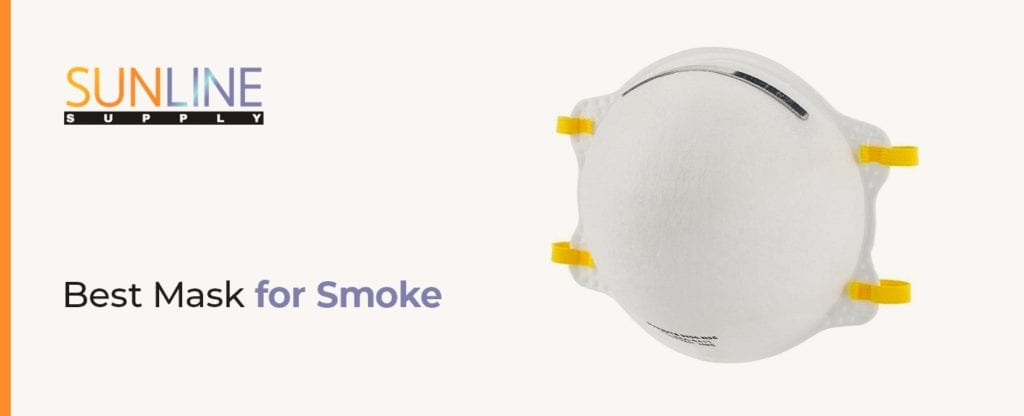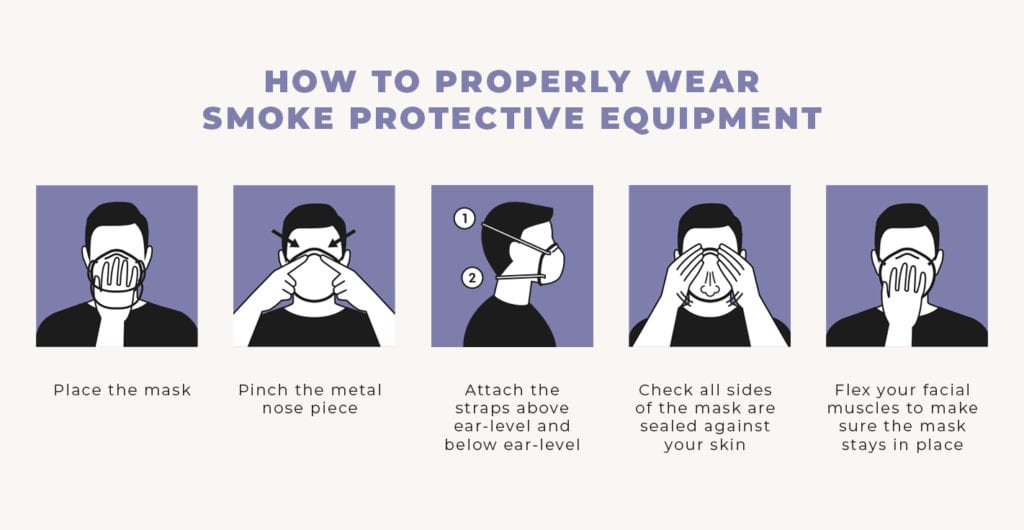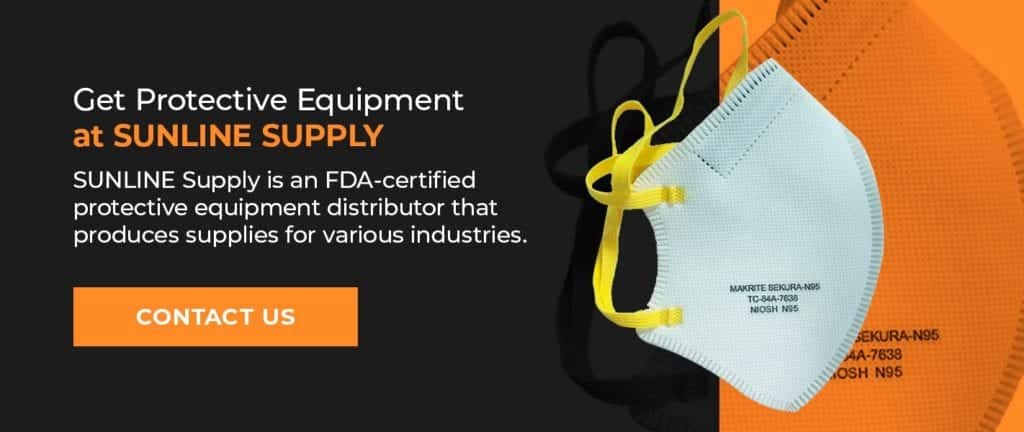
Best Mask for Smoke
Smoke from fires leads to poor air quality that is dangerous to your health. If you’re unable to remove yourself and seek clean air, the best line of defense is wearing high-quality protective equipment, including smoke-filtering masks.
Best Mask to Prevent Smoke Inhalation
For protection against smoke, you need a particulate respirator or gas mask. Particulate respirators are a type of face mask that filters small smoke, soot and ash particles. They are the most common form of protective equipment against smoke. If you’re unable to stay indoors or seek clean air, a respirator will help protect your lungs.
If you have a preexisting lung condition or heart disease, you should wear a smoke respirator even when staying indoors if wildfire smoke is present. Gas masks, also known as air-purifying respirators, offer similar protection to a particulate respirator but can also protect you against some types of gases and fumes. They require a separate filtration system.
When choosing a mask for smoke, make sure it:
- Is tested and approved by NIOSH: All smoke masks should be tested and approved by the National Institute for Occupational Safety and Health (NIOSH). NIOSH imposes a strict set of quality and filtration standards against specific hazards. Look for a NIOSH approval label on the mask or packaging and note which threats it’s suitable for safeguarding against.
- Has two separate straps: All smoke masks should have two separate face straps for maximum coverage. Masks with a single strap or two ear loop straps will not sit securely against your face.
- Has a clearly displayed rating: Look for masks with a clearly stated rating, which will tell you the level of protection it provides. N95 respirator masks are the most common and usually the most easily accessible. The “95” means the mask can filter out at least 95% of small particles if you fit and use it correctly. The higher the rating, the more effective the mask will be at filtration. Please note that high mask ratings, like an N100, also make breathing more challenging.
- Has an exhale valve: Some respirator masks have an exhale valve for more comfortable breathing and ventilation. These are advisable if you plan to be around smoke for an extended period.
- Has built-in adjustable straps: Though not necessary, adjustable straps are the best way to make sure your mask fits tightly against your head without falling or gapping.
- Fits securely against your face: No matter how high-quality your mask is, it’s useless if it doesn’t fit correctly. Choose a mask that has enough movement to contour around your face without creating any gaps. Whenever possible, choose one made with lightweight materials, so it’s easier to breathe and stay cool. Some people, like those with beards, may need a specially sized mask or must shave before wearing it for a secure fit.
Why Wear Masks for Smoke Pollution?
Although the best form of protection is avoiding smoke, this isn’t always possible. Smoke masks are a crucial piece of protective equipment because they minimize the amount of smoke and ash that enters your airways in situations requiring prolonged smoke exposure. Smoke is dangerous for everyone, but some people are more vulnerable to side effects than others, like young children, older adults, people with asthma or lung disease, those with heart conditions, pregnant women and anyone who struggles to breathe on their own.
Exposure to structural and wildfire smoke can lead to serious health consequences that endanger the following areas:
- Lungs: Smoke will increase mucus production and cause repetitive coughing. It could also create a dangerous blockage in your lungs.
- Eyes: Smoke exposure will cause stinging, burning and redness in the eyes. In some cases, smoke and particles could damage your corneas. Wear an eye shield if possible.
- Throat: Breathing in smoke particles will inflame your throat and nasal passages, making them sore and scratchy. You may also find soot- or smoke-colored secretions when you blow your nose.
- Head: Smoke inhalation causes exposure to carbon monoxide, which will make you dizzy and nauseous and give you a headache. Additional symptoms may include vomiting, reduced alertness, confusion, dizziness, fainting or seizures. Extreme cases could result in a coma.
- Chest: Smoke may cause chest pain, excessive wheezing, shortness of breath and increased heartbeat. This is from the lack of oxygen in your blood, which leads to low oxygen flow to your heart.
Should you begin to experience any of the above symptoms, seek fresh air immediately, and call for emergency medical assistance. A medical professional can administer clean oxygen, treat carbon monoxide poisoning and give you medicine to relax your airways.
How to Properly Wear Smoke Protective Equipment

For your safety, consider investing in a smoke mask before you need it — especially if you live in an area prone to wildfires. Should there be a fire, monitor daily air quality reports and avoid leaving your home if possible. Always follow all safety guidelines and recommendations and evacuate when necessary.
When it’s time to put on your smoke mask, follow these steps:
- Place the mask over your nose and under your chin.
- If your mask has a metal nose piece, pinch it against the bridge of your nose.
- Attach one strap above ear-level and around the back of your head.
- Secure the second strap below ear-level and around the back of your head.
- Check that all sides of the mask are sealed against your skin with no gaps.
- Flex your facial muscles to make sure the mask stays in place and adjust if necessary.
- Once your mask is dirty — or whenever it gets hard to breathe with it on — throw it away and replace it with a new one.
If you have a health condition that makes it difficult to breathe, consult your doctor before wearing a smoke mask. When wearing your mask, remove it and seek fresh air if you become dizzy or have trouble breathing. Avoid wearing a mask if you have to be physically active or exposed to high temperatures. Stay hydrated and take frequent breaks with fresh air, if possible.
Masks That Do Not Offer Personal Protection From Smoke Pollution
When investing in protective equipment, quality is vital. The following masks offer no protection against smoke or ash:
- DIY masks, like bandanas.
- Face gaiters.
- Surgical masks.
- Costume masks.
- Dust masks.
- Paper masks.
- Knit or mesh masks.
- Used or dirty masks.
- Masks that do not fit.
- Masks without listed ratings and approval.
Get Protective Equipment at SUNLINE SUPPLY
SUNLINE Supply is a company that distributes protective equipment and produces supplies for various industries. Contact a SUNLINE Supply representative to learn more about workplace safety and get the PPE you need today!


